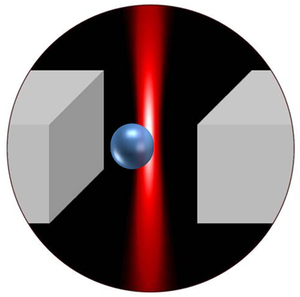Millikan’s Experiment Takes the Next Step
Researchers have observed fluctuations in charge on a plastic bead at the level of individual elementary charges, an experiment that is reminiscent of the measurement of the electron’s charge by Robert Millikan a century ago. It’s the first measurement of elementary charging events at a solid-liquid interface. As the team reports in Physical Review Letters, they used an oscillating electric field to measure the charge on a microsphere submerged in a liquid. Understanding such charging processes is increasingly important for commercial products that involve small, charged particles, such as the “e-ink” in the Kindle e-book reader display, and for industrial processes, such as stabilization of soot in petroleum.
Researchers often make colloids of tiny plastic beads dispersed in a fluid as a model for interacting molecules or particles of dust, for example. They usually describe the random charging and discharging of the beads using an approximation that ignores the granular nature of charge, which has been difficult to measure. About years ago, Robert Millikan, then at the University of Chicago, measured the charge of an electron by trapping tiny, charged oil drops in an electric field [1]. To measure single charge fluctuations on beads, Filip Beunis of Ghent University in Belgium and his collaborators have now come up with a system reminiscent of Millikan’s.
The team used a colloid of -micron-diameter PMMA (“Plexiglas”) spheres in the liquid dodecane. They inserted two electrodes, microns apart, into the colloid and applied an oscillating voltage across them, holding a microsphere loosely in place between the electrodes with an optical (laser) trap.
If it was charged, the microsphere oscillated in response to the applied voltage, and the amplitude of the motion was a measure of the total charge on the particle. The trick was to set the experimental parameters so that the random motion was much less than the purely oscillatory motion. The team also needed to measure the sphere’s charge frequently enough that individual charging and discharging events wouldn’t be missed. They found that these events occurred about twice per second, so measuring charge at hertz was sufficient.
The team’s plot of the bead’s amplitude versus time showed up and down “stair steps”—rather than smooth ramps—indicating the discrete nature of the charging and discharging events. The size of the steps led to a value for the elementary charge that agreed to within percent of the accepted value for the charge of the electron.
To explain the data, the researchers propose a model wherein a fixed number of sites on each sphere can become charged when an ion dissociates (breaks off) from the sphere, making the sphere more negatively charged with each dissociation. The ions can also re-associate with the sphere and reduce its charge. Fitting the data, they say an average sphere had charging sites, about of which were charged at any particular time. Overall, they say the model demonstrates that it is possible, with a simple, few-parameter theory, to study charging processes involving a few tens of molecular sites.
“A beautiful class of experiments, with astonishing resolution,” says Ángel Delgado of the University of Granada in Spain. The new work “takes us from the (apparently old) classical colloid science to the very basis of the physics of charged interfaces,” he says. Kishan Dholakia of the University of St Andrews, Scotland, is also impressed. “This opens up the prospect of a new range of dynamical studies of charging processes at solid-liquid interfaces.” He says that if the work can be extended to polar liquids we might gain new insights into the solvent properties of water.
–David Harris
David Harris is a freelance science writer in Palo Alto, California.
References
- R. A. Millikan, “The Isolation of an Ion, a Precision Measurement of its Charge, and the Correction of Stokes’s Law,” Phys. Rev. (Series I) 32, 349 (1911); “On the Elementary Electrical Charge and the Avogadro Constant,” Phys. Rev. 2, 109 (1913)





